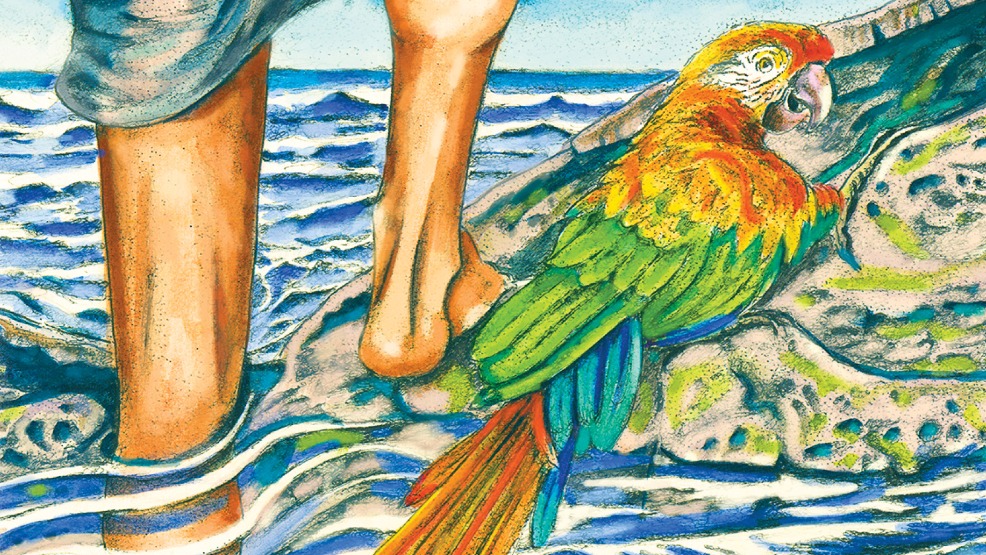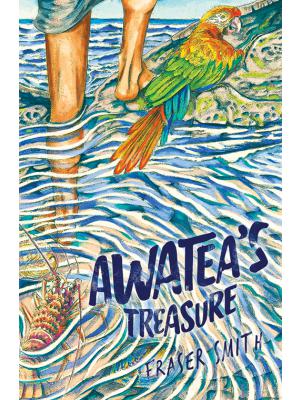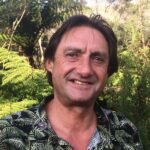School principal Fraser Smith writes about how his debut children’s novel Awatea’s Treasure went from idea to manuscript to published book.

Awatea’s Treasure began on a School Camp, sitting around a fire on round rocks still warm from the sun, with the breaking swell rolling smaller rocks up and down the steep shoreline ten metres away. During a gap between stories, songs and jokes, my class of 30 Year Five students requested a story from me.
I played a couple of minor chords on my guitar, set up a spooky little riff, and started singing. Then I made up all sorts of stories about an almost-ghost … perhaps real, but perhaps not. The moreporks in the pohutukawa trees above helped out, and the odd screeching kiwi added to the mood.
The kids huddled closer to the fire and I had them glued. The fire was the only light, and the whites of their eyes told me the mood was right.
The stories grew and improved with many kids’ input over many years. We’d have three nights to grow the stories, and I usually forgot what I had told the night before, so the kids had to remind me of where we were up to. One common-sense rule on camp was not to get the kids too scared or they wouldn’t sleep. The tent walls that separated us were thin. We all needed sleep. I couldn’t get them too wound up and had to make sure I sent them off to their sleeping bags with a soothing ending to any story.
One common-sense rule on camp was not to get the kids too scared or they wouldn’t sleep.
Later, as a School Principal, I was often asked to look after a class at very short notice. Stories came in handy there. Awatea’s Treasure is a small taste of many such stories.
While on a sabbatical looking into ways to inspire boys to write, I took to writing myself. I’ve since used some of that writing in other schools to turn kids onto the writing process. One holiday I put a pile of stuff together and sent it off to Huia Publishers. It wasn’t good enough, but they put me in a writing workshop run by Kate De Goldi. After that three-day workshop, I was hooked.
I re-wrote my stories, changing from the first to the third person to get more flexibility. A friend had a sister who was an editor. She kindly took the manuscript, pulled me up, and whipped me into shape to rewrite it one more time. After another ‘holiday’ spent writing, I was pushed by my partner into resubmitting the manuscript. By then I was ready for more rejection. I was pleased to learn that the editing was so precise it only needed to go to the ‘comma person’ and it was accepted for publication.
Along the way, my good friend Patrick White liked the story and read it to some intermediate classes. He happened to be an artist so he drew the cover. I sent the manuscript to Sam Hunt, then Jack Lasenby, and waited with fear and trepidation for their opinions. It was elating to find their response was also very positive!
The writing bug has bitten me now and I am over halfway through writing a sequel. I am still a primary school principal and the only time I can muster up to write is during school holidays. The stories keep coming, and when I sit down to write I lose track of everything else for hours. Right now, Awatea and Carrot haven’t finished with me, but there are other characters and settings waiting. Plots seem to thicken themselves.
The stories keep coming … Plots seem to thicken themselves.
My Uncle Kim inspired some of these stories because he was so kind and clever, and capable of the most creative practical jokes. Sometimes his tricks were terrifying … but we could always laugh about them afterwards.
Kim’s oldest sister was my mother, Miriam Smith. She and my father, Allan, were creative, caring people: writers, artists and political change-makers. There were no limits and many horizons that they inspired and lifted for me. I have a gifted whānau and very strong tupuna at my back.
The environment I lived in as a child, and live in now, is an inspiration too. The bush, the sea, and country places continue to provide opportunities for fun, food, danger and great beauty.


Fraser Smith
Fraser Smith is principal of Oturu School in Kaitāia, a Green-Gold Enviroschool where the curriculum is delivered in a hands-on, practical way, supported by the community. The school has beehives, chickens, fruit trees, vegetable gardens and a registered kitchen. Fraser is a keen fisherman and sailor who knows how to live from the resources of the sea and the bush. He also writes stories and songs, and plays and sings in a band.



